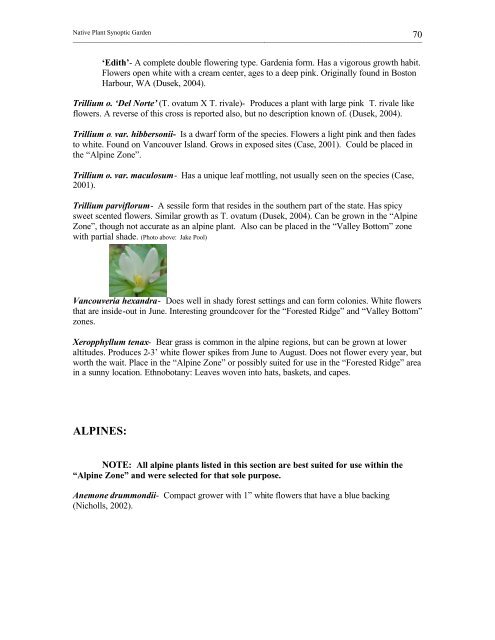Full page photo print - WSU Puyallup Research and Extension ...
Full page photo print - WSU Puyallup Research and Extension ...
Full page photo print - WSU Puyallup Research and Extension ...
You also want an ePaper? Increase the reach of your titles
YUMPU automatically turns print PDFs into web optimized ePapers that Google loves.
Native Plant Synoptic Garden<br />
70<br />
____________________________________________________________________________________________________________<br />
‘Edith’- A complete double flowering type. Gardenia form. Has a vigorous growth habit.<br />
Flowers open white with a cream center, ages to a deep pink. Originally found in Boston<br />
Harbour, WA (Dusek, 2004).<br />
Trillium o. ‘Del Norte’ (T. ovatum X T. rivale)- Produces a plant with large pink T. rivale like<br />
flowers. A reverse of this cross is reported also, but no description known of. (Dusek, 2004).<br />
Trillium o. var. hibbersonii- Is a dwarf form of the species. Flowers a light pink <strong>and</strong> then fades<br />
to white. Found on Vancouver Isl<strong>and</strong>. Grows in exposed sites (Case, 2001). Could be placed in<br />
the “Alpine Zone”.<br />
Trillium o. var. maculosum- Has a unique leaf mottling, not usually seen on the species (Case,<br />
2001).<br />
Trillium parviflorum- A sessile form that resides in the southern part of the state. Has spicy<br />
sweet scented flowers. Similar growth as T. ovatum (Dusek, 2004). Can be grown in the “Alpine<br />
Zone”, though not accurate as an alpine plant. Also can be placed in the “Valley Bottom” zone<br />
with partial shade. (Photo above: Jake Pool)<br />
Vancouveria hex<strong>and</strong>ra- Does well in shady forest settings <strong>and</strong> can form colonies. White flowers<br />
that are inside-out in June. Interesting groundcover for the “Forested Ridge” <strong>and</strong> “Valley Bottom”<br />
zones.<br />
Xeropphyllum tenax- Bear grass is common in the alpine regions, but can be grown at lower<br />
altitudes. Produces 2-3’ white flower spikes from June to August. Does not flower every year, but<br />
worth the wait. Place in the “Alpine Zone” or possibly suited for use in the “Forested Ridge” area<br />
in a sunny location. Ethnobotany: Leaves woven into hats, baskets, <strong>and</strong> capes.<br />
ALPINES:<br />
NOTE: All alpine plants listed in this section are best suited for use within the<br />
“Alpine Zone” <strong>and</strong> were selected for that sole purpose.<br />
Anemone drummondii- Compact grower with 1” white flowers that have a blue backing<br />
(Nicholls, 2002).

















